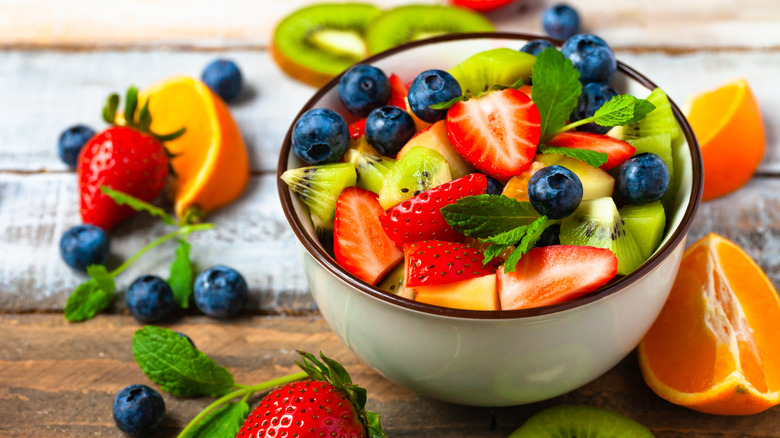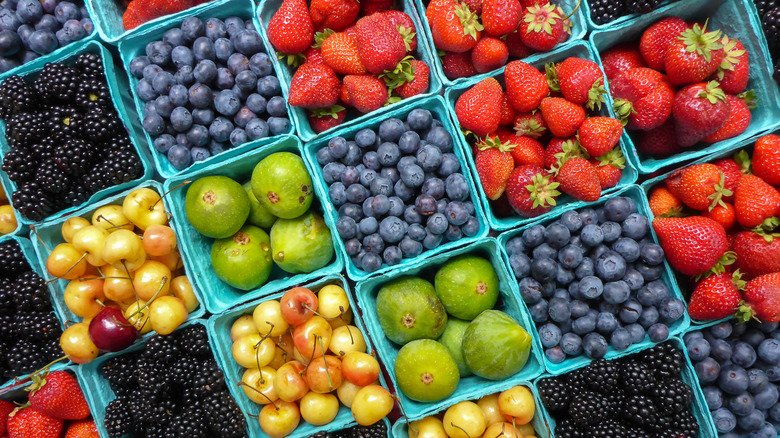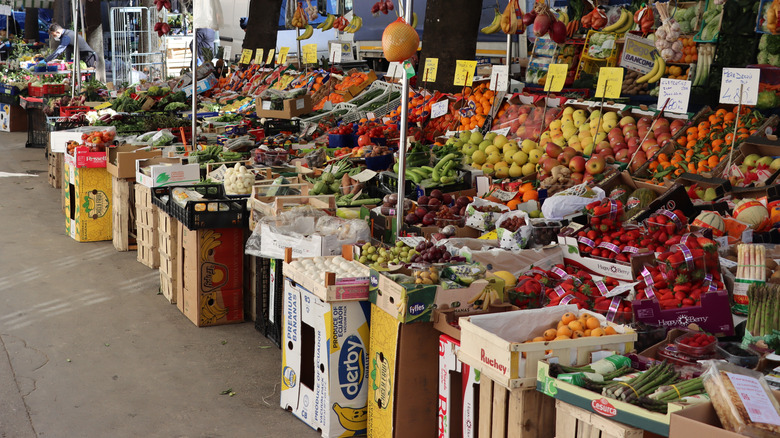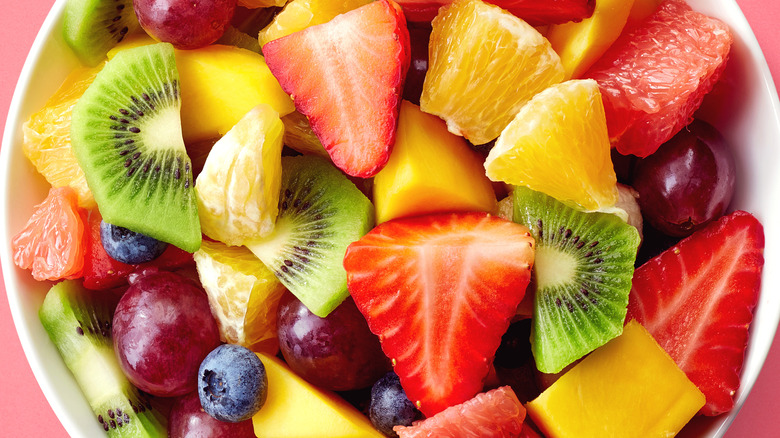What You Should Consider When Picking Out Fruit Salad Ingredients
In addition to being a breakfast staple, the classic fruit salad splashes its colors at backyard barbecues, summer block parties, kickbacks, picnics, and wherever else you could possibly bring it. Almost always a crowd-pleaser, if you've ever eaten a less-than-stellar fruit salad you'll know they're not all created equal.
The perfect fruit salad scores high in appearance, flavor, and texture, but hitting all three of these categories can be tough. With the wrong fruit choice or under or overripe ingredients, your perfect side dish could go from sweet and fresh to boring and bland or saccharine and mushy. Use these guidelines to try and maximize the three perfect fruit salad categories — visual appeal, flavor and taste, and texture — at your next grocery store or farmers market perusal. With the ideal combination of standout produce and a deft choosing hand, your fruit salad could end up being the star of the function and blow all the other options away.
For fruit salad, visuals matter
One of the first things you're likely to notice when it comes to fruit salad is the naturally bright colors, enticing you with a gorgeous rainbow of fruit. To have a standout visual dish, choose a variety of fruit to create intrigue for the eye. No one color should overpower another (unless you're experimenting with a monochromatic fruit salad), which in addition to creating a pleasing visual will help keep the flavors balanced (per Wonder How To). And while you can't do anything about what Slate calls "pickers" (or the people who scoop around their least favorite fruits in the salad, wreaking havoc on your well-planned side) starting with an uneven mix is a surefire way to end up with a bowl full of cantaloupe or whatever other fruit has been cast aside by choosey guests.
On top of looking beautiful, culinary scientist Jessica Gavin explains using a rainbow of fruit will add a wider range of nutrients and antioxidants to the dish than a more simple fruit salad.
Another trick to add visual appeal to your dish is to add herbs like fresh mint or basil: chop some up to mix in for a unique flavor and include a few whole leaves on top for a nice garnish. You could also get creative and test other fruit salad décor, like edible flowers. Consider the colors of your fruits when choosing garnishes to achieve the perfect color palette.
Balance your fruit salad flavors
Once you've made the decision to dig into your beautiful fruit salad, you'll of course immediately taste the flavors presented, so pick your fruit with care. To keep your salad stellar, choose fruits that pair well together.
Some classic pairings will always be safe, like opting for an all berry or all tropical fruit salad, but don't be afraid to try some combos tested by pastry chef and blogger the Baker's Almanac, like cherries, oranges, and plums or kiwi, papaya, and strawberries. It may be wise to avoid plain, filler fruits like cantaloupe and honeydew, which Thrillist laments don't add much flavor or pizazz to the dish.
Wonder How To instructs you to consider choosing fruits that are all in season at the same time to strengthen the flavor profile. While it may not be possible year-round, for the freshest fruit with the best flavor you might want to hit your local farmers market instead of the grocery store or buy directly from a farm yourself, that way you can be sure everything is perfectly flavorful and even potentially ask the farmer for recommendations.
Consider fruit texture
There's nothing worse than a mushy fruit salad. To combat this, Wonder How To says to try choosing fruits that are all the same relative of ripeness. (In addition to being ultra-flavorful, this is another reason you may want to opt for in-season fruits from a farm stand or market over the standard grocery store fare. The farmer may even be able to point you in the direction of which fruits will last until you're ready to use them.) Fruits that are overripe will soften in the salad the longer they sit and affect the other fruits, so grab your produce slightly unripe if you're buying in advance.
Fruits that oxidize quickly — like bananas, apples, and apricots — might not be the best choice for your salad, as even at their peak they can turn brown and soft faster than you might expect once cut (via Sciencing). If you plan to use one or more of these fruits in your fruit salad, you may want to toss them with some citrus juice, the acidity of which Serious Eats says will keep the browning at bay for a little while. But if you're making your fruit salad far in advance, it's probably wiser just to skip for textural and visual appeal.



